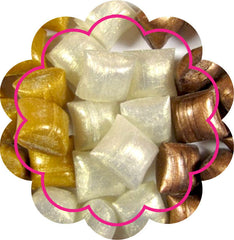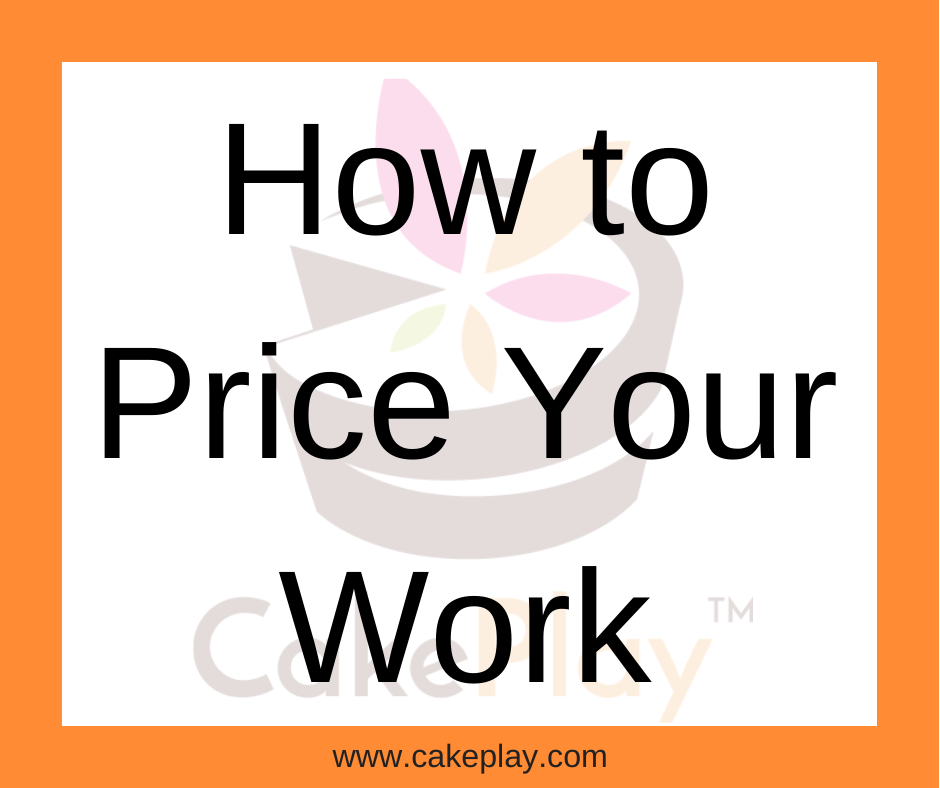How to Price Your Work
- Anna Weisend
- 08 Jul 2020
“What should I charge for my cake/cookie/cupcake/cakepop/chocolate/lollipop/pie/candy/snack?”…is the still the most popular question received by most instructors.
The answer is something closely related to this…”That depends.”
It depends on where you live: Different parts of the country have different standards of living and therefore prices are different.
It depends on what type of product you offer: Are you making a cake with a cake mix with shortening buttercream or a chiffon cake with a European buttercream? One costs more than the other.
It depends on the service you offer: Are you pumping out a standard product or are you offering customization? Customization will likely use more of your time.
It depends on your business model: Are you pick up only, local delivery, or long-distance delivery? Do you have a stand-alone bakery? Are you offering your product at local farmers' markets? Do you have an in-home bakery? Each has different costs.
So the best answer is “If you know your costs, you will know how to charge.”
And if you are truly a business owner you will do the work to find out.
How to Break it Down
The only way to truly know how to charge correctly is knowing what your expenses are. You have to break down the cost of every recipe and then break down the cost of every serving (slice of cake, cupcake, cake pop, piece of candy, etc.).
Yes, this means a TON of math and basic knowledge of measurement equivalents. If you don’t like math, enlist a helper. You can do this by hand, with the help of an excel spreadsheet, or using free or paid for apps available on the internet.
Start With Food Costs or Cost of Goods Sold
Break down each recipe by ingredient.
If you are measuring your ingredients, you will already conveniently have the correct measurements to break the recipe down. If you are weighing in metric but live in the USA you will have to convert metric to imperial.
If you are measuring by volume, you will have to find the weight of a particular unit of measure. Example: Your recipe calls for 3 cups of AP flour. You need to determine how much one cup weighs (4 ¼ oz or 120 g). The reason that this is important is that you purchase your flour by the pound or the Kilogram. You do not purchase flour by the cup so it would be impossible to determine your costs using that number.
We are going to assume that the majority of our readers are American and use the imperial system and all examples will include that. If you live anywhere else in the world, you will need to convert it to metric.
Using the same flour example, you now need to find out how much 1 cup of flour costs.
If you purchase a 50lb bag of flour for $65.33, you would break it down first into pounds: $65.33 divided by 50 = $1.3066 or round up to $1.31/pound.
Now you would need to break it down to the ounce. $1.31 divided by 16 ounces= $.081875 or rounded up to $.09/ounce.
Therefore $.09 x 4.25 (or 4 ¼)=$.3825 or rounded up to $.39/cup. ***Editors note: I have always rounded up to the next penny because it involves money and rounding down would mean leaving money on the table. While a fraction of a penny might not mean a lot for one item, it will mean a lot when you become a mogul or if you go bankrupt!***
Every single ingredient must be done like this. Always figure out the lowest common denominator. For some products, this might mean by the teaspoon or for something like eggs it would be per each. Do not be tempted to cut corners here or your costs will not be accurate.
Below is a spreadsheet showing an example using chocolates.
|
Ingredent |
Cost |
Cost per lb |
Cost per oz |
Amount used |
Cost per piece |
Total cost per bar |
Total with Almonds |
Total cost per box |
Mixed box of 3 each |
|||
|
Chocolate Bars |
$44.29 |
$4.42 |
$0.28 |
3.5 ozs |
$0.98 |
|||||||
|
Almonds |
$12.00 |
$12.00 |
$0.75 |
1 oz |
$0.75 |
|||||||
|
Bar wrapper |
$7.99 |
100 pieces |
$0.08 |
0.08 |
||||||||
|
Labor with labeling |
$2.00 |
|||||||||||
|
$3.06 |
$3.81 |
Into food cost, you must also add the cost of supplies. Food cost+ supplies= Cost of Goods Sold
Anything you need to send out that product must be included, examples: Boxes, Labels, Cake board, cupcake liners, candy cups, dowel rods, lollipop sticks, cellophane bags, ribbon, etc. Again, break it down to the lowest common denominator- how much is one cupcake liner? How much is 1 inch of ribbon and how many inches do you need?
You must also figure in any indirect supplies (meaning things you use to make the product but doesn’t necessarily leave the workspace) this is your overhead Examples : parchment, plastic wrap, pan spray, gloves (yes, every single glove), food coloring, cost of utilities, cleaning supplies, rent, marketing materials, maintenance. Some of these items can be broken down like food cost and some like, rent, need to be broken down into how many of “X” you are selling (the more you sell, the smaller the rent gets per piece). Some will be trickier like the utilities, you will need to figure out how to figure out your usage per item per month and break it down from there based on your sales.
Once you have broken down each recipe, you can then break it down by serving. Ex: A cupcake recipe and a buttercream recipe that produces 24 cupcakes may cost $17.76 to create. $17.76 divided by 24= $.74/cupcake.
The total Cost of Goods sold should be 20%-33% of the cost of the product. To lower this portion of the product price, you can review your purchasing decisions and try to get ingredients at a better price point.
Labor Costs Come Next
Labor HAS to be factored into the cost of items because no one works for free.
Do a test run on your products. How long does it take you to make them and how much should you (or your employee get paid for an hour? If you can make, ice and box, and clean up 72 cupcakes in an hour and a half and you pay yourself or your employee $15.00 per hour you need to break it down to the lowest common denominator: $22.50 divided by 72 = $.3125/ cupcake. Round up to $.32/cupcake.
The total labor costs should be 25%-35% of the cost of your product. To lower this portion of the product price, you or your employee needs to work faster and do more in less time.
Now Add Profit
Yes, even if you are the employee getting paid to make those cupcakes, you need to add profit. Why? Some day you may want to expand and if you hire someone to do that work you will be able to keep none of it.
Profit should be 35%-50% of your product price.
Using our cupcake example: Cost and labor come to $1.06 per cupcake, that would mean that the final cupcake price would be $1.59- $2.12/cupcake. For customer ease you many want to round it up to the nearest quarter or $1.75-$2.25/cupcake.
So you have a range. What price do you pick?
Time to shop your neighborhood.
Comparison Shop
Start secret shopping similar businesses to yours. See what others in the area are doing, what differentiates them from you, what prices they are charging…
…BUT BEWARE…
Make sure you are comparing apples to apples. Are they offering the same size cupcakes? Are they filled or unfilled? Are they using real buttercream or the frosting with the shortening in it? Are they minimally or heavily decorated? Do they taste good? Are they more attractively packaged? Is the quality the same?
If you are not comparing like to like you can hurt yourself a lot in the long run.
Also be aware that it is unlikely that you can out price a big box or warehouse store, but it is extremely likely that you can beat them at taste and presentation and you must charge accordingly.
Consider Your Experience
If you are brand new you may want to charge on the lowest end until you have had a little more practice. If you are a seasoned veteran who can turn out consistent, almost perfect results than you might want to charge on the higher end.
What You Must NEVER Do
You should never ever, ever, ever, ever, ever, ever, ever, ever underprice yourself. Do not try to undercut a competitor. You lose money this way. You also develop the reputation as being the “cheap”, “bargain basement”, “run of the mill” purveyor. With that reputation, you will immediately repel those who would be willing to pay you the going rate on suspicion that it isn’t as good as the others and if the day comes when you do actually start charging the way you should, the value clients will leave immediately and you will be in a vicious cycle between your cash flow and getting paid for what you are worth.
So choose within that range carefully. But choose and make a stand.
Formulas and Record-Keeping
UGH! The majority of creative people despise this part. Yes, it feels like it is hurting your brain but it doesn’t actually kill you and will make you profitable.
You can figure out each recipe using paper and pen, an excel spreadsheet, hire someone to do it, or use an app cleverly designed to do the grueling mental work for you.
Fortunately, there are others who have gone before you and you can tap into their business IQ and just do a little data entry.
While CakePlay Inc does not recommend any of these specifically and has not tried any of them personally, below you will find a list of possibilities. Some come with a fee, some are free, choose what works for you.
What Next?
So you’ve done all the work, you know what prices you need to charge appropriately, and you are all finished! YEAH!
Nope.
You need to do this process at a minimum of every year. If for any reason there is an unreasonably large spike in the cost of ingredients, you would also have to reevaluate at that time.
Now you are a proper entrepreneur. And you will never have to ask another living soul, “What should I charge for this?”




